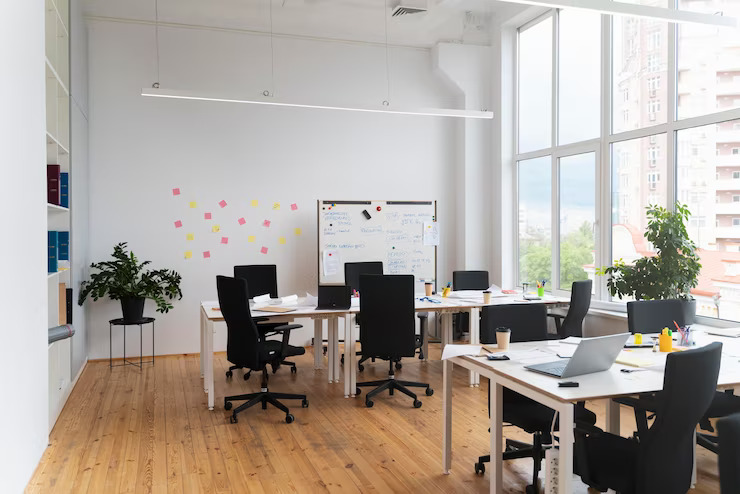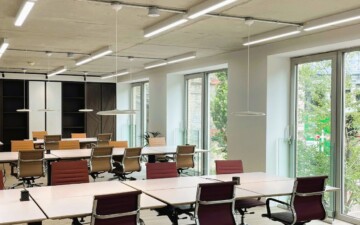With increasing awareness of the severity and consequences of climate change, the conversation around ‘sustainability’ has taken centre stage in recent years. According to the International Energy Agency, operating buildings account for 30% of global energy consumption, and 26% of global energy-related emissions. Naturally, how and where we work has a large role to play in contributing to our carbon footprint. As more businesses return to physical offices full-time after the pandemic, both shared and private office spaces are placing a greater emphasis on sustainable office design.
Fortunately, a growing concern for conserving our planet’s resources is translating into sustainable practices across industries. With sustainable private office spaces, businesses have an opportunity to reduce their carbon footprint. By choosing workspaces equipped with energy-efficient technologies, and eco-friendly waste management protocols, businesses can contribute to a healthier planet while unlocking growth opportunities.
Sustainable workspaces have a direct impact on boosting operational efficiency and employee well-being. Thus, choosing sustainable private offices is a step towards environmental consciousness that has long-term benefits for both businesses and our planet.
What is a Sustainable Office Space?
A sustainable private office space is a workplace designed, operated, and maintained to minimise environmental impact and promote ecological balance. A sustainable workspace incorporates natural elements like plants, ample sunlight, and organic materials. Sustainable shared workspaces commit to using energy efficiently, incorporating responsible resource management, and proper waste reduction and recycling measures.
“The question is, what constitutes a sustainable office? A workspace that promotes ecological and environmental balance by reducing the depletion of natural resources.”
Some hallmark qualities of sustainable office space include:
- Utilising green building materials: Sustainable offices often use materials that are recycled, renewable, or have low environmental impact during production and disposal. Examples include recycled steel, reclaimed wood, bamboo, and low-VOC paints.
- LED lights: LED (Light Emitting Diode) lighting is energy-efficient, lasting longer and consuming less electricity than traditional fluorescent or incandescent bulbs. This reduces energy consumption plus lowers operating costs.
- Improved indoor air quality: Sustainable offices prioritise air quality by using HVAC systems with efficient filters and proper ventilation. Low-VOC (Volatile Organic Compound) materials and furnishings help maintain healthier indoor air quality for employees.
- Efficient layout and design: Efficient space planning and design can maximise natural light exposure, reduce energy consumption, and promote collaboration among employees. This includes using open floor plans, flexible workspace arrangements, and ergonomic furniture.
- Eco-friendly office supplies: Sustainable offices choose supplies that are made from recycled materials or ones that are easily recyclable. This includes paper products, stationery, and cleaning supplies.
Key elements of sustainable offices
Creating a sustainable office space involves incorporating various elements that aim to minimise environmental impact, enhance employee well-being, and optimise resource efficiency. Here are the key elements one should consider while designing a sustainable office space:
- Energy Efficiency: Implementing energy-efficient lighting, heating, ventilation, and air conditioning (HVAC) systems can significantly reduce energy consumption. This includes using LED lighting, smart thermostats, and efficient appliances.
- Water Conservation: Installing water-saving fixtures such as low-flow toilets, faucets, and sensor-operated taps can minimise water usage. Additionally, implementing water-efficient landscaping strategies can reduce outdoor water consumption.
- Waste Reduction and Recycling: Encouraging recycling by providing marked recycling bins for paper, plastic, glass, and other recyclable materials. Reducing waste through practices like double-sided printing and minimising disposable items can also contribute towards sustainability.
- Indoor Air Quality: Enhancing indoor air quality by using low-emission materials for furnishings, paints, and finishes. Ensuring proper ventilation and air filtration systems can improve employee health and productivity.
- Natural Light and Biophilic Design: Maximising natural light through well-designed windows and skylights can reduce the need for artificial lighting. Biophilic design principles, which incorporate natural elements like plants and green walls, can enhance employee well-being and connection to nature.
- Transportation Options: Promoting alternative transportation options such as bikes, and incentives for carpooling or the use of public transportation encourages sustainable commuting practices among employees.
- Energy Management Systems: Implementing advanced energy management systems to monitor and optimise energy use in real-time can identify areas for improvement and reduce overall energy consumption.
- Sustainable Purchasing Policies: Adopting policies that prioritise purchasing environmentally friendly products, from office supplies to furniture, helps reduce the office’s overall environmental footprint.
- Employee Engagement and Education: Educating employees about sustainability practices and encouraging their participation in energy-saving initiatives or waste-reduction programs fosters a culture of sustainability within the office.
Why are sustainable offices important?
Sustainable offices are essential for several reasons. They reduce environmental impact through energy and water conservation, waste minimisation, and the use of eco-friendly materials. This results in lower operational costs and long-term savings. Sustainable offices also enhance employee well-being with healthier air quality, natural lighting, and ergonomic furniture, leading to higher job satisfaction and productivity. Additionally, adopting sustainable practices boosts a company’s reputation and attracts eco-conscious clients and employees. It ensures compliance with environmental regulations and can qualify businesses for financial incentives. Overall, sustainable offices support long-term business success while contributing positively to the environment and community.
What are 10 ways to make your office more sustainable?
Here are 10 ways to make your office more sustainable:
- Energy-efficient lighting: Use LED bulbs and automatic light sensors.
- Reduce paper use: Implement digital documentation and double-sided printing.
- Recycling programs: Set up recycling bins for paper, plastic, and electronics.
- Eco-friendly office supplies: Choose products made from recycled materials.
- Green commuting: Encourage biking, walking, and public transport.
- Energy-saving devices: Use energy-efficient appliances and equipment.
- Sustainable furniture: Invest in furniture made from sustainable materials.
- Indoor plants: Improve air quality with office plants.
- Water conservation: Install low-flow fixtures and promote water-saving habits.
- Waste reduction: Implement composting and reduce single-use items.
Benefits of Choosing Eco-friendly Offices
Regardless of their size, businesses must embrace sustainable workspaces for long-term benefits for both the environment and their bottom line.
1. Increasing Productivity
Enhancing employee productivity is a major concern for businesses. Research has highlighted how sustainable private office spaces with higher Indoor Environment Quality (IEQ) factors, such as lighting, temperature, noise control, and air quality, contribute to a healthier work environment, thereby enhancing employee productivity. Sustainable private office spaces incorporate elements such as lush greenery, vertical gardens or living walls, and interiors made from sustainable materials like wood and stone, all of which work together to create an ambience conducive to maximising productivity.
2. Reducing Carbon Footprint
“Carbon footprint” refers to greenhouse gas emissions, primarily carbon dioxide, generated by companies, events, people, and products. Sustainable private office spaces play a crucial role in ecological restoration by effectively reducing carbon footprint since they utilise reusable materials, implement proper recycling policies, and utilise energy-saving appliances. By adopting sustainable practices such as reusing and recycling, these offices follow an eco-friendly and responsible approach to daily work.
3. Resource Optimisation
Sustainable private spaces in co-working offices use and share resources, thus reducing overall environmental impact. In shared working spaces, private offices make efficient use of communal equipment and facilities, rather than each member or company relying on their own individual items. For instance, private office spaces in a co-working space often share conference rooms, printers, and other office supplies with members.
4. Improving Brand Perception
With an increasing awareness of environmental concerns, businesses that embrace eco-friendly practices have much to gain by way of public recognition. Since companies have a responsibility not just towards their stakeholders, but also society at large, an initiative towards contributing to a greener planet can have a positive impact on brand reputation. Thus, the commitment to preserving our planet can directly benefit your business by attracting new customers who seek services from environmentally responsible companies.
Opt for Sustainable Office Solutions with Garden Office Bermondsey
A recent study reveals that 55% of commercial property professionals observed an increased demand for ‘sustainable’ and ‘green’ buildings in 2022. Here is how Garden Office Bermondsey has designed sustainable office spaces for rent with flexible options, ranging from private office spaces to meeting rooms:
1. Abundant Natural Light
When selecting a workspace or office, the availability of natural light is essential. Natural light diminishes reliance on artificial lighting, leading to lower energy consumption and decreased costs. Garden Office Bermondsey’s private offices are designed to allow abundant natural light in, helping improve focus and well-being. Ample natural light has been proven to improve concentration in the workplace by eliminating headaches, eye strain, and drowsiness. With Garden Office Bermondsey’s well-lit workspaces, you can boost productivity for your team, while contributing towards reducing your carbon footprint.
2. Recycling Practices
Incorporating recycling protocols in the workspace is vital for promoting sustainability. By adhering to strict recycling guidelines, conserving resources, and reducing waste, Garden Office Bermondsey minimises its ecological impact. Garden Office Bermondsey is committed to effectively recycling paper, plastics, and electronics, preserving raw materials and curbing energy consumption.
3. Biophilic Office Design
Garden Office Bermondsey’s office spaces feature a thoughtfully-crafted biophilic design. This approach integrates natural elements such as plants, ample natural light, and sustainable materials, creating a visually stunning, productive, and healthy workspace. By incorporating greenery and maximising natural light, Garden Office Bermondsey promotes high air quality, reduced stress, improved creativity, and enhanced well-being.
Establishing Sustainable Office Policies and Practices
Implement sustainable office policies like reducing paper use, promoting energy-efficient practices, recycling, and encouraging telecommuting to minimise environmental impact and foster an eco-conscious workplace culture.
Measuring and Monitoring the Environmental Impact of a Sustainable Office Space
Measuring and monitoring environmental impact involves tracking energy consumption, waste generation, water usage, and carbon emissions. Use metrics like carbon footprint calculations and periodic audits to assess progress toward sustainability goals and identify areas for improvement in a sustainable office space.
Future Trends in Sustainable Office Spaces
Future trends in sustainable office spaces include greater integration of renewable energy sources like solar and wind, adoption of smart building technologies for energy efficiency, implementation of biophilic design for improved indoor air quality and employee well-being, and continued emphasis on remote work to reduce commuting emissions.
The Path to a Sustainable Office Space
Achieve a sustainable office space through steps like energy-efficient lighting, smart HVAC systems, waste reduction through recycling and composting, promoting paperless operations, implementing green procurement policies, encouraging remote work, and fostering a culture of sustainability among employees. Regular monitoring and adjustments ensure ongoing improvement toward environmental goals.
Why Choose Garden Office Bermondsey as a sustainable office?
In both our personal and professional lives, it is crucial to collectively embrace the responsibility of promoting a healthier planet. By actively participating in sustainable practices, such as reducing waste and conserving resources, we can contribute to a more environmentally conscious global community and work towards a sustainable future. Similarly, by choosing sustainable office spaces, businesses can optimise their work environments while committing to a greener planet. This aligns with the growing awareness of environmental responsibility, providing businesses with a competitive edge to attract environmentally-conscious customers.
Experience eco-conscious private office spaces at Garden Office Bermondsey and join us on our journey towards a greener tomorrow!





